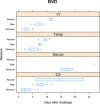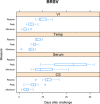Structured literature review of responses of cattle to viral and bacterial pathogens causing bovine respiratory disease complex
- PMID: 25929158
- PMCID: PMC4895424
- DOI: 10.1111/jvim.12597
Structured literature review of responses of cattle to viral and bacterial pathogens causing bovine respiratory disease complex
Abstract
Bovine respiratory disease (BRD) is an economically important disease of cattle and continues to be an intensely studied topic. However, literature summarizing the time between pathogen exposure and clinical signs, shedding, and seroconversion is minimal. A structured literature review of the published literature was performed to determine cattle responses (time from pathogen exposure to clinical signs, shedding, and seroconversion) in challenge models using common BRD viral and bacterial pathogens. After review a descriptive analysis of published studies using common BRD pathogen challenge studies was performed. Inclusion criteria were single pathogen challenge studies with no treatment or vaccination evaluating outcomes of interest: clinical signs, shedding, and seroconversion. Pathogens of interest included: bovine viral diarrhea virus (BVDV), bovine herpesvirus type 1 (BHV-1), parainfluenza-3 virus, bovine respiratory syncytial virus, Mannheimia haemolytica, Mycoplasma bovis, Pastuerella multocida, and Histophilus somni. Thirty-five studies and 64 trials were included for analysis. The median days to the resolution of clinical signs after BVDV challenge was 15 and shedding was not detected on day 12 postchallenge. Resolution of BHV-1 shedding resolved on day 12 and clinical signs on day 12 postchallenge. Bovine respiratory syncytial virus ceased shedding on day 9 and median time to resolution of clinical signs was on day 12 postchallenge. M. haemolytica resolved clinical signs 8 days postchallenge. This literature review and descriptive analysis can serve as a resource to assist in designing challenge model studies and potentially aid in estimation of duration of clinical disease and shedding after natural pathogen exposure.
Keywords: Bovine respiratory disease; Bovine respiratory syncytial virus; Bovine viral diarrhea; Cattle; Infectious bovine rhinotracheitis; Mannheimia haemolytica; Mycoplasma bovis; Parainfluenza-3; Virus shedding.
Copyright © 2015 The Authors. Journal of Veterinary Internal Medicine published by Wiley Periodicals, Inc. on behalf of the American College of Veterinary Internal Medicine.
Figures







References
-
- USDA . Part IV: Health and Health Management on U.S. Feedlots With a Capacity of 1,000 or More Head. In: APHIS , ed. Fort Collins, CO: National Animal Health Monitoring System; 2011.
-
- Broderson B, Kelling CL. Effect of concurrent experimentally induced bovine respiratory syncytial virus and bovine viral diarrhea virus infection on respiratory tract and enteric disease in calves. Am J Vet Res 1998;59:1423–1430. - PubMed
-
- Salt JS, Thevasagayam SJ, Wiseman A, et al. Efficacy of a quadrivalent vaccine against respiratory diseases caused by BHV‐1, PI3V, BVDV and BRSV in experimentally infected calves. Vet J 2007;174:616–626. - PubMed
-
- Van der Poel W, Schrijver R, Middel W, et al. Experimental reproduction of respiratory disease in calves with non‐cell‐culture passaged bovine respiratory syncytial virus. Vet Quart 1996;18:81–86. - PubMed
-
- Smith RA, Stokka GL, Radostits OM, Griffin DD. Health and production management in beef feedlots In: Radostits O, ed. Herd Health: Food Animal Production Medicine, 3rd ed Philadelphia: W.B. Saunders Company; 2001:581–633.
Publication types
MeSH terms
LinkOut - more resources
Full Text Sources
Other Literature Sources

